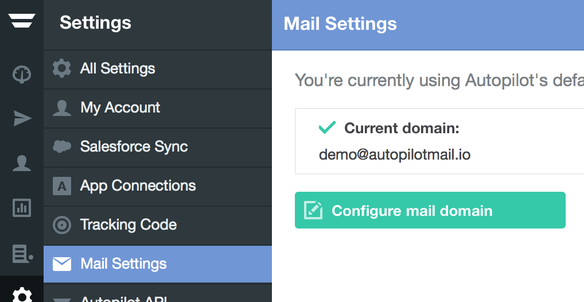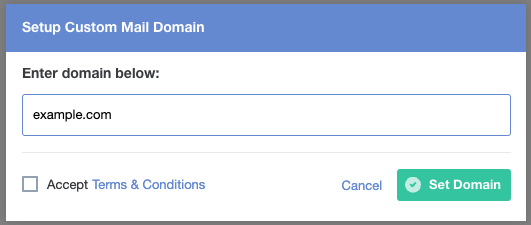Autopilot: How to set up your custom email domain in Autopilot
Join thousands of companies including Patreon, Greenpeace and Microsoft and setup your custom domain to personalize your emails.
How does configuring a custom email domain work?
Autopilot can be configured to deliver email on behalf of your email domain. This doesn't mean the email will come directly from your email provider (e.g. Gmail), instead it will be sent on behalf of your domain through Autopilot's mail servers.
Think of it like this: we are posting a letter on your behalf, but with your return address on it. As far as the recipient is concerned, the email they receive looks exactly like you personally sent it.
This is typical with marketing automation software and provides many benefits, for example:
- we have specialists constantly monitoring and tuning our email servers to ensure the best possible deliverability rates; and
- by using our mail servers, you're not subjected to sending limits set by providers such as Gmail (if you used such a provider, your email would end up bouncing on large sends).
What happens if I don't configure a custom email domain?
Until you complete this configuration:
- Autopilot will send email from a pre-assigned domain name at our email server (i.e. youraccountname@autopilotmail.io); and
- anything you enter in the "From Email" field will be used, by default, as the "Reply-to" email address (i.e. the email won't come from that address, but when people click reply, it will insert what you entered in the "From Email" field. This ensures you receive replies to any emails you send). This can be changed to something other than the "From Email" if you wish to do so. Learn more here.
Once you've completed the configuration, your email will come from the address you put into the "From Email" field.
Does configuring a custom email domain affect my incoming mail or any other aspect of my existing email setup?
No, it will not. It will simply provide the necessary permission for Autopilot to send on your behalf.
How to configure your email domain
1. Go to Mail Settings and then click "Configure mail domain":

2. Enter your domain name, e.g. example.com:

3. To complete the setup, five DNS record changes are required to verify ownership of the domain. You may require someone from IT to help with this step as it requires logging into the host provider account where you registered the domain name to make the changes.
Note: do not use the values below, this is just an example. Please use the values listed in your account.

The three basic types of records that will need to be added or changed are ‘CNAME’ (aka Alias), ‘A’ (aka Host) and ‘TXT’ (aka Text) records. The way you add these record types will vary depending on your domain provider's interface.
Example DNS provider interface:

Once you find where you add a DNS record you can copy the values directly out of the text boxes provided in Autopilot's DNS set-up page. Sometimes the host record does not contain the ‘yourdomain.com’ portion, if that is the case, it means it has been automatically included. You may also find that the wording of what we have labeled ‘host record’ and ‘value’ may be slightly different. If you encounter difficulty changing your DNS records, it can help to read your domain providers documentation.
Here are links to popular domain hosting providers' documentation:
4. Once you've made these changes, you can verify them by clicking "Test DNS Setup":

Note: changes to your DNS records can be immediate or may take hours to update, depending on your provider. Our DNS test will only detect live changes.
5. When a change is verified as correct, a green tick appears in the Status column. When all of the DNS changes are verified, click "Confirm Domain".
6. You're done and your custom domain request has been submitted for review. We will notify you by email when your custom domain request has been approved and is ready to use.
Your configured domain
Once you have configured your domain and we have approved it, it will appear as below:

The default address is used if you create a new email and don't change the "From Email". However you can change easily the "From Email" to be anything@yourdomain.com on an email by email basis.
The default address is also used as the "From Email" in internal notification emails.
Please note, if you need to change your email domain once it has been configured, please contact us. The reason we don't allow multiple changes is to ensure that Autopilot is not used for improper purposes.
Common errors
- You have more than one SPF record. You need to combine your SPF records into one record. Multiple SPF records may cause delivery and spam classification issues.
- You can only have one Sender ID TXT record that starts with ‘v=spf1 ….’. This may present an issue if you need more than one for other domain verifications (e.g. Google Analytics). Luckily, there is a way around this: add the entries between the ‘v=spf’ and ‘-all’ like so: “v=spf1 include:spf.autopilothq.com include:google.com -all”.
- Don’t forget your periods at the end of your DKIM and Bounces/SP records. While easily overlooked, this will throw an error in our DNS validation.
- Remember to add 'include:sendgrid.net' to the Sender ID record so that it looks like: 'v=spf1 mx include:spf.autopilothq.com include:sendgrid.net -all'.
- Network Solutions can take up to 24 hours for any DNS changes to take place. Please keep this in mind when checking your Autopilot account right after making changes.
- Blue Host will sometimes use a ‘?’ instead of a ‘-’ in front of the ‘all’ in their Sender ID, however this will throw an error in our DNS validation. To fix this, update the Sender ID in your DNS records to use a ‘-’, instead of the ‘?’.
- Amazon Web Services, or AWS, does not allow the '@' for configuring a Sender ID. Please use your normal domain name as the host.
- GoDaddy does not allow '.' at the end of a DKIM CNAME entry. It must be 'sharedpool._domainkey.autopilothq.com'
- OVH has some trouble saving underscores in a CNAME record for DKIM in their new interface. Here is a work around from their Support team:
- Create the CNAME record without underscores
- Go to the "old customer interface" (Managerv3) and then to DNS Zone .
- Click on "View DNS zone in text mode"
- Add the underscores to the Autopilot CNAME line in the text editor.
